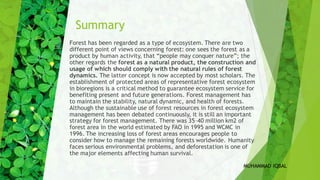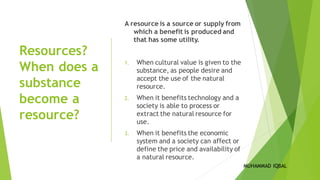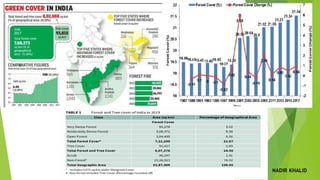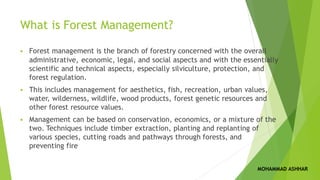Forest Resources and Management
- 1. Forest Resources and Management By: MOHAMMAD IQBAL, MOINUDDIN KHAN, ROSHAN RAI, MOHAMMAD ASHHAR, NADIR KHALID
- 2. FORESTS? The Food and Agriculture Organization defines a forest as land spanning more than 0.5 hectares with trees higher than 5 meters and a canopy cover of more than 10 percent, or trees able to reach these thresholds in situ. Forests cover nearly one-third of the land globally The world has a total forest area of 4.06 billion hectares (ha), which is 31 percent of the total land area MUHAMMAD IQBAL
- 3. Summary Forest has been regarded as a type of ecosystem. There are two different point of views concerning forest: one sees the forest as a product by human activity, that “people may conquer nature”; the other regards the forest as a natural product, the construction and usage of which should comply with the natural rules of forest dynamics. The latter concept is now accepted by most scholars. The establishment of protected areas of representative forest ecosystem in bioregions is a critical method to guarantee ecosystem service for benefiting present and future generations. Forest management has to maintain the stability, natural dynamic, and health of forests. Although the sustainable use of forest resources in forest ecosystem management has been debated continuously, it is still an important strategy for forest management. There was 35–40 million km2 of forest area in the world estimated by FAO in 1995 and WCMC in 1996. The increasing loss of forest areas encourages people to consider how to manage the remaining forests worldwide. Humanity faces serious environmental problems, and deforestation is one of the major elements affecting human survival. MUHAMMAD IQBAL
- 4. Resources? When does a substance become a resource? A resource is a source or supply from which a benefit is produced and that has some utility. 1. When cultural value is given to the substance, as people desire and accept the use of the natural resource. 2. When it benefits technology and a society is able to process or extract the natural resource for use. 3. When it benefits the economic system and a society can affect or define the price and availability of a natural resource. MUHAMMAD IQBAL
- 5. The Status of World Forests ➢ The forest area is the area notified and recorded as forest land irrespective of the existence of trees, while the actual forest cover is the area actually occupied by forests. ➢ Forests cover 31 percent of the global land area. Approximately half the forest area is relatively intact, and more than one-third is primary forest (i.e. naturally regenerated forests of native species, where there are no visible indications of human activities and the ecological processes are not significantly disturbed). ➢ The total forest area is 4.06 billion hectares, but forests are not equally distributed around the globe. ➢ Among all continents, Africa has largest forested area (33%) followed by Latin America (25%), whereas in North America forest cover is only 11%. Asia and former USSR has 14% area under forest. European countries have only 3% area under forest cover. ➢ More than half of the world’s forests are found in only five countries (the Russian Federation, Brazil, Canada, the United States of America and China) and two-thirds (66 percent) of forests are found in ten countries. NADIR KHALID
- 6. The Status of World Forests NADIR KHALID
- 7. NADIR KHALID
- 8. FOREST STATISTICS OF INDIA ❖ The total forest cover in India is (72 million hectares), which is 21.67% of the total geographical area. ❖ Area-wise Madhya Pradesh has the largest forest cover in the country followed by Arunachal Pradesh, Chhattisgarh, Odisha and Maharashtra. ❖ Haryana had the lowest forest cover with respect to total geographical area in India at 6.79 percent. Trailing closely behind was the state of Punjab with 6.87 percent tree cover. ❖ Mizoram has nearly 90% area of state under forest, followed by Arunachal Pradesh. Madhya Pradesh has largest area under forest. ❖ The India State of Forest Report (ISFR) 2019 released recently shows an increase of 5,188 square kilometers of forest and tree cover across the country compared to the ISFR 2017. ❖ However, the report highlights that northeast India continues to lose forests when compared to ISFR 2017 and previous reports. ❖ The forest report also reveals that the forest area under the category “recorded forest area” (land notified as forest by the government) in tribal districts, which are home to about 60 percent of India’s forests, is decreasing as well. NADIR KHALID
- 9. NADIR KHALID
- 10. FOREST RESOURCES: USES 1. Commercial values ▪ Forests are main source of many commercial products such as wood, timber, pulpwood etc. About 1.5 billion people depend upon fuel wood as an energy source. Timber obtained from the forest can used to make plywood, board, doors and windows, furniture, and agriculture implements and sports goods. Timber is also a raw material for preparation of paper, rayon and film. ▪ Forest can provide food, fibre, edible oils and drugs. ▪ Forest lands are also used for agriculture and grazing. ▪ Forest is important source of development of dams, recreation and mining 2. Ecological uses ▪ Forests are habitat to all wild animals, plants and support millions of species. They help in reducing global warming caused by greenhouse gases and produces oxygen upon photosynthesis. Forest can act as pollution purifier by absorbing toxic gases. Forest not only helps in soil conservation but also helps to regulate the hydrological cycle. MOHAMMAD ASHHAR
- 11. FOREST RESOURCES: USES 3. Life and economy of tribal ▪ Forest provide food, medicine and other products needed for tribal people and play a vital role in the life and economy of tribes living in the forest. 4. Aesthetic values ▪ All over the world people appreciate the beauty and tranquillity of the forest because forests have a greatest aesthetic value. Forest provides opportunity for recreation and ecosystem research. MOHAMMAD ASHHAR
- 13. What is Forest Management? ▪ Forest management is the branch of forestry concerned with the overall administrative, economic, legal, and social aspects and with the essentially scientific and technical aspects, especially silviculture, protection, and forest regulation. ▪ This includes management for aesthetics, fish, recreation, urban values, water, wilderness, wildlife, wood products, forest genetic resources and other forest resource values. ▪ Management can be based on conservation, economics, or a mixture of the two. Techniques include timber extraction, planting and replanting of various species, cutting roads and pathways through forests, and preventing fire MOHAMMAD ASHHAR
- 14. Need for Forest Management ➢ Extinction of Thousands of Species - Millions of plants and animal species are in danger of disappearing as a result of deforestation. ➢ Heavy Soil Erosion -One function of the forest is that its roots hold the soil in place ➢ Greenhouse Effect -The continued degradation of our forest heightens the threat of global warming ➢ Flooding-One major importance of forest is that they absorb water quickly in great amount during heavy rains and avoid floods. ➢ Landslides- Trees prevent soil from getting eroded by natural agents like wind or water ➢ Degraded Watershed -When forest mountains are denuded, watersheds are degraded and this leads to the loss of sustained water supplies for lowland communities. MOHAMMAD ASHHAR
- 15. SUSTAINABLE FOREST MANAGEMENT Sustainable forest management, also known as sustainable forestry, is the practice of regulating forest resources to meet the needs of society and industry while preserving the forest's health. Therefore, sustainable forest management is always looking to strike a balance between the demand for the forest's natural resources and the vitality of the forest. Objectives of SFM: ❑ Continuously satisfying needs for goods and environmental services from forests ❑ Ensuring the conservation of forest soils, water and carbon stocks ❑ Conserving biodiversity ❑ Maintaining the resilience and renewal capacity of forests, including for carbon storage ❑ Supporting the food-security, cultural and livelihood needs of forest- dependent communities ❑ Ensuring the equitable sharing of responsibilities in forest management and of the benefits arising from forest use. ROSHAN RAI
- 16. Strategies for Sustainable Forestry management ❖ Maintain a stable forest land base. This concept embraces strong sustainability and stresses the fact that goods and services provided by forests are irreplaceable. Thus, human-created capital is no substitute for forest land. Likewise loss of northern forests cannot be fully compensated by offsetting gains in forest area in other parts of the United States or the World ❖ Maintain or increase forest biodiversity. This includes sustaining diverse populations of native plants and animals, diversity of forest ecosystems and habitats across the landscape, and genetic diversity of forest associated plants and animals ❖ Maintain or increase forest-based employment and community stability. Commercial forest operations may be the most economical means of altering forest structure and composition in ways that are essential to achieving other goals such as habitat restoration, hazardous fuel reduction, or invasive species mitigation ❖ • Increase environmental literacy and engage a wide range of stakeholders in sustainable forest management ROSHAN RAI
- 17. Approaches and Strategies for SFM ❖ Maintain a system of institutions, policies, regulations, and incentives that support forest sustainability at multiple spatial scales ❖ Maintain or increase the capacity for sustained yield of timber and nontimber forest products and associated economic development. ❖ Maintain or increase soil productivity and minimize soil erosion and contamination ❖ Maintain or enhance the quantity and quality of forest recreation and other opportunities for people to experience forests. ❖ Maintain or increase the quality and quantity of water from forest ecosystems. ROSHAN RAI
- 18. Laws and regulations: Forestry Laws in India ➢ INDIAN FOREST ACT, 1927: The main objects of the Act are: 1. To consolidate the laws relating to forests. 2. Regulation of and the transit of forest produce. And, 3. To levy duty on timber and other forest produce DRAWBACKS OF THE INDIAN FOREST ACT, 1927 1. A deep investigationof the act reveals that the act never aimed to protect the vegetation cover of India 2. It also deprived the nomads and the tribal people of their age old rights and privileges to use the forests and forests produce. 3. It mainly aimed at supplying raw material for forest based industries 4. It denied common ownership or occupancy rights or property rights to the occupants of land/tribal. 5. It failed to protect the forests from unscientific and unplannedexploitation MOINUDDIN KHAN
- 19. Forestry Laws in India ❖ FOREST CONSERVATIONACT, 1980 ➢ The Act was passed with a view to check deforestation. The basic aim of the Act was to provide for the conservation of forests and for matters connected therewith. ➢ Under the provisions of this Act, prior approval of the Central Government is essential for diversion of forest lands for the non-forestry purposes. ❖ THE SCHEDULED TRIBE AND OTHER TRADITIONAL FOREST DWELLERS (RECOGNITION OF FOREST RIGHTS) ACT, 2006 ➢ This act aimed at giving ownership rights over forestland to traditional forest dwellers. ❖ MADRAS FOREST ACT, 1882 ➢ The Act made provision for the protection and management of forests in the Madras presidency. MOINUDDIN KHAN
- 20. Conclusion ❑ One of the biggest challenges towards the outlook of forests in the recent times has been concerns about ‘sustainability’ of our resources. It has emerged as one of the main concerns of recent policy advocacy ❑ Forest has been regarded as a type of ecosystem. The conservation, restoration, and sustainable use of forest ecosystems and biodiversity are the basic issues for forest resource management. ❑ Forest is a natural product, so the construction and usage it should comply with the natural rules of forest dynamics ❑ The National Forest Commission, has recommended creating an enabling environment to facilitate assessment, monitoring and reporting on national-level criteria and indicators for sustainable forest management 20 MOINUDDIN KHAN
- 21. Thank you




















